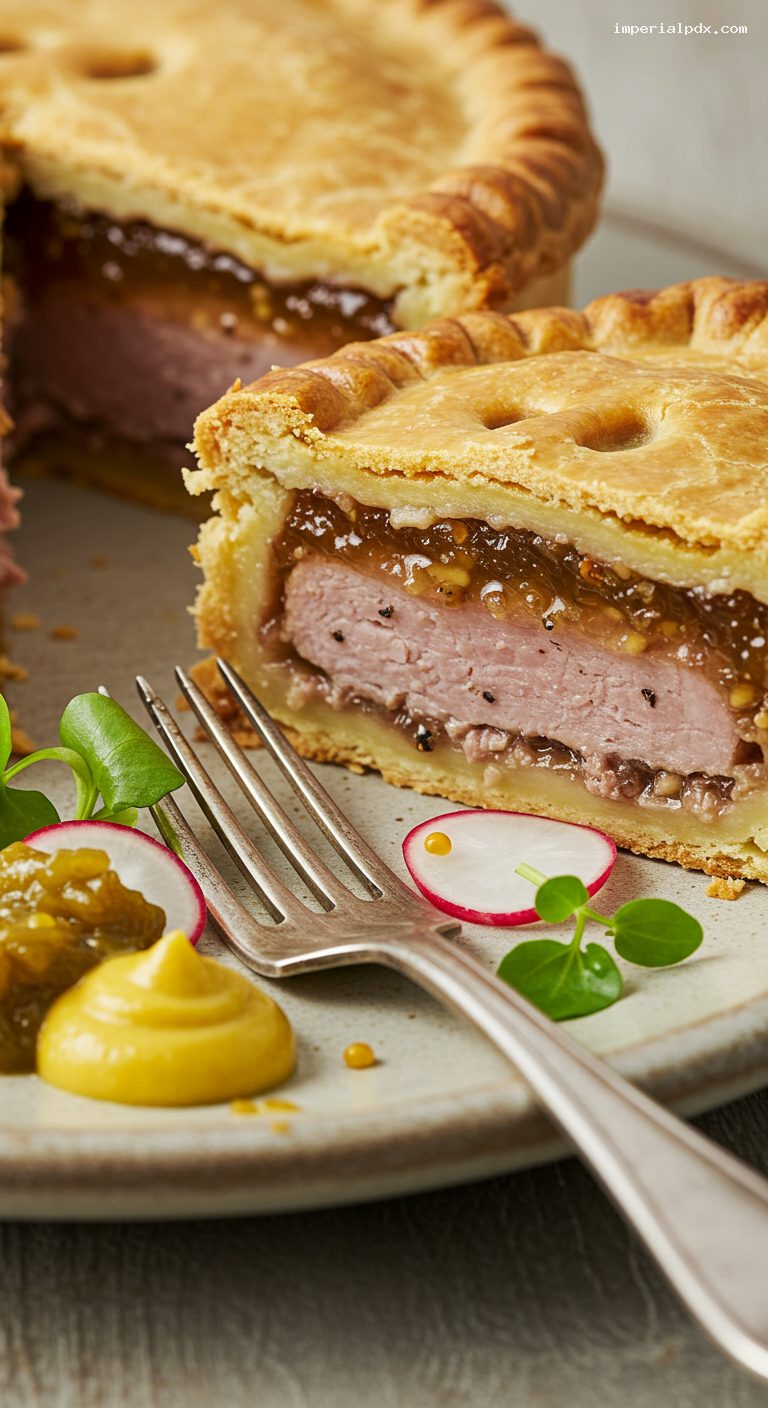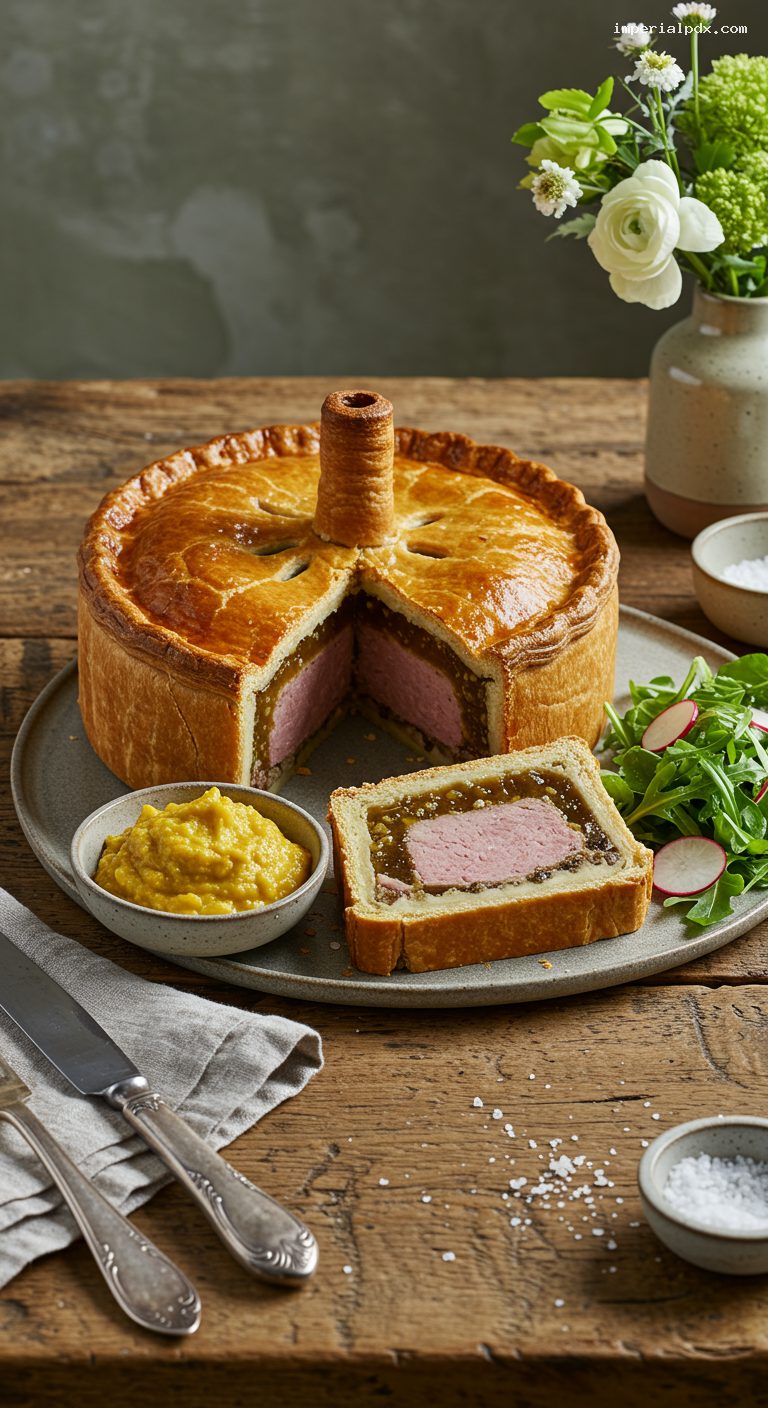Quick Recipe Version (TL;DR)
Quick Ingredients
- Plain flour 500 g; fine salt 1 tsp
- Lard 125 g; unsalted butter 75 g; water 200 ml
- Pork shoulder 900 g; pork belly/back fat 150 g (1 cm dice)
- Sea salt 14 g; black pepper 2 tsp; dried thyme 1 tsp; mace 1/2 tsp; allspice 1/2 tsp; nutmeg 1/4 tsp; mustard powder 1 tsp
- Egg 1 + milk 1 tbsp (wash)
- Rich pork stock 650 ml; powdered gelatine 12 g; bay leaf 1; cider vinegar 1 tsp
- To serve: jarred piccalilli (250 g), watercress/rocket 120 g, radishes 6, olive oil 1 tbsp, cider vinegar 1 tsp
Do This
- 1. Mix diced pork with seasonings; chill.
- 2. Make hot-water crust: melt lard and butter in water; stir into flour/salt; knead warm.
- 3. Hand-raise pastry over an oiled 1-litre jar/dolly; form a 15 cm wide, 7–8 cm tall shell; chill 30 minutes.
- 4. Pack in pork; add lid, crimp, and cut a 1 cm chimney; egg-wash.
- 5. Bake 30 min at 200°C/180°C fan (400°F), then 50–60 min at 170°C/150°C fan (340°F) until 75°C/167°F internal.
- 6. Simmer stock with bay; whisk in gelatine and vinegar; cool to warm; pour into chimney until full; chill 4+ hours.
- 7. Slice cold; serve with piccalilli and a peppery salad.
Why You’ll Love This Recipe
- True hand-raised hot-water crust with a golden, crimped finish—no tin required.
- Coarse-seasoned pork sets beautifully in savoury, gently spiced jelly for a classic slice.
- Make-ahead friendly: bakes one day, jellies overnight, and slices perfectly the next.
- Balanced plate: rich pie with sharp piccalilli and a clean, peppery salad.
Grocery List
- Produce: Watercress, rocket (arugula), radishes
- Dairy: Unsalted butter, egg, milk
- Pantry: Plain flour, lard, pork shoulder, pork belly or back fat, rich pork stock, powdered gelatine, piccalilli, olive oil, cider vinegar, bay leaf, dried thyme, black pepper, ground mace, ground allspice, nutmeg, mustard powder, fine salt
Full Ingredients
Hot-Water Crust Pastry
- Plain (all-purpose) flour: 500 g
- Fine sea salt: 1 tsp (6 g)
- Lard: 125 g
- Unsalted butter: 75 g
- Water: 200 ml
- Extra flour for dusting
Coarse-Seasoned Pork Filling
- Pork shoulder, well-trimmed, diced 1 cm: 900 g
- Pork belly or back fat, skin removed, diced 1 cm: 150 g
- Fine sea salt: 14 g (about 2 1/4 tsp)
- Freshly ground black pepper: 2 tsp
- Dried thyme: 1 tsp
- Ground mace: 1/2 tsp
- Ground allspice: 1/2 tsp
- Freshly grated nutmeg: 1/4 tsp
- English mustard powder: 1 tsp
Egg Wash
- Egg: 1, beaten
- Milk: 1 tbsp
Savoury Jelly
- Rich pork stock (unsalted or low salt): 650 ml
- Powdered gelatine: 12 g (about 4 tsp), or 6 gold gelatine leaves
- Bay leaf: 1
- Cider vinegar: 1 tsp
To Serve
- Piccalilli: 1 jar (about 250 g)
- Peppery salad: watercress and rocket 120 g; radishes 6, thinly sliced
- Extra-virgin olive oil: 1 tbsp; cider vinegar 1 tsp; pinch of salt and pepper

Step-by-Step Instructions
Step 1: Season the pork
Combine the diced pork shoulder and belly/back fat in a large bowl. Add the salt, black pepper, thyme, mace, allspice, nutmeg, and mustard powder. Toss thoroughly until every piece is evenly coated. Cover and refrigerate while you make the pastry. Chilling firms the fat and helps the filling pack tightly without smearing.
Step 2: Make the hot-water crust
In a heatproof jug, bring the water just to a simmer. Add the lard and butter and heat until fully melted. In a large bowl, mix the flour and fine salt. Pour the hot fat-and-water mixture into the flour and stir with a wooden spoon until it forms a rough dough. Turn out and knead 1–2 minutes while still warm until smooth. Keep the dough warm and workable; cover with a bowl to prevent cooling as you set up for shaping.
Step 3: Hand-raise the pie shell
Lightly oil a straight-sided 1-litre jar or a wooden pie dolly about 7.5 cm (3 in) radius. Pinch off about one-quarter of the dough for the lid and keep warm, covered. Shape the remaining dough into a thick disc. Place it over the inverted, oiled jar/dolly and gently work the dough downwards with your palms, keeping an even thickness (about 8–10 mm) and forming a 15 cm diameter base with 7–8 cm tall sides.
Lift the formed shell onto a parchment-lined baking sheet. Slide the jar/dolly out. Wrap a doubled strip of baking parchment around the outside as a loose collar and tie with string to support the walls while chilling and the initial bake. Chill the shell for 30 minutes to firm up.
Step 4: Fill, lid, crimp, and chimney
Heat the oven to 200°C/180°C fan/400°F. Pack the chilled pork filling firmly into the pastry shell, pressing down well and slightly doming the top; tight packing reduces air pockets. Roll the reserved dough to a circle to fit as a lid. Brush the rim of the shell with a little beaten egg, place the lid on, and crimp all around to seal. Cut a neat 1 cm chimney in the centre for steam and, later, the jelly. Egg-wash the top and sides.
Step 5: Bake until golden and safe
Bake on the middle shelf for 30 minutes. Reduce the temperature to 170°C/150°C fan/340°F, remove the parchment collar, egg-wash again if you like, and bake a further 50–60 minutes. The crust should be deep golden and an instant-read thermometer inserted into the centre should read at least 75°C/167°F. If browning too quickly, tent loosely with foil. Transfer the pie to a rack and cool until warm (45–60 minutes); the crust should feel set but not cold.
Step 6: Make and pour the savoury jelly
While the pie cools, warm the stock with the bay leaf for 5 minutes; remove the bay. If using powdered gelatine, whisk it into the hot stock off the heat until dissolved; if using leaves, soak them in cold water for 5 minutes, squeeze, then whisk in. Stir in the cider vinegar. Let the jelly cool to about 50°C/120°F so it is warm and fluid but not hot enough to melt the pastry.
Using a small funnel or spouted jug, slowly pour the jelly into the chimney until it rises to the brim. Wait 10 minutes as it settles into gaps, then top up. Repeat until no more will go in. Chill uncovered for 30 minutes, then cover and refrigerate at least 4 hours, preferably overnight, until the jelly is fully set.
Step 7: Slice and serve
Serve the pie cold. For clean slices, use a sharp serrated knife warmed in hot water and wiped dry between cuts. Plate with a generous spoon of sharp piccalilli and a peppery salad of watercress and rocket tossed with olive oil, cider vinegar, salt, and thinly sliced radishes.
Pro Tips
- Keep the pastry warm and pliable while shaping; if it cools and cracks, briefly warm your hands and smooth the surface.
- A parchment-and-string collar supports the walls during the crucial first bake—remove once the crust has set.
- Pack the pork tightly to minimise voids; less air inside means less jelly leakage later.
- Top up the jelly twice: once immediately and again after 10–15 minutes as it seeps into gaps.
- For a neat crimp, pinch and push the lid edge against the wall in small, even pleats all the way round.
Variations
- Mini hand-raised pies: Divide dough and filling into 6 portions; bake 20 minutes at 200°C/180°C fan then 25–30 minutes at 170°C/150°C fan. Pipe in jelly as above.
- Herb and pepper crust: Add 1 tsp cracked black pepper and 1 tsp dried sage to the flour for a speckled, aromatic crust.
- Game pie twist: Substitute half the pork with diced venison or rabbit; season as written and use the same jelly ratio.
Storage & Make-Ahead
The finished pie keeps, covered and refrigerated, for up to 4 days; flavour improves on day 2. For best texture, do not freeze once jellied. If you must freeze, bake and cool the pie but add no jelly; wrap well and freeze up to 2 months. Thaw in the fridge, warm gently to room-cool, then add warm jelly and chill to set. Leftover slices should be kept cold and eaten within 48 hours.
Nutrition (per serving)
Approximate, for 1 of 10 slices (pie only, without sides): 620 kcal; fat 38 g; saturated fat 15 g; carbohydrates 36 g; sugars 1 g; fiber 2 g; protein 34 g; sodium 940 mg.


